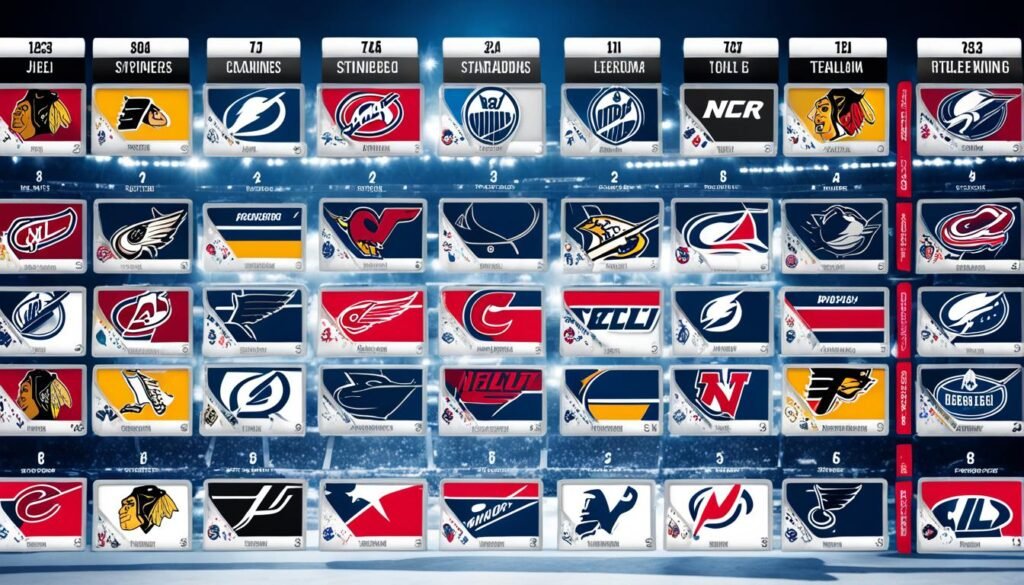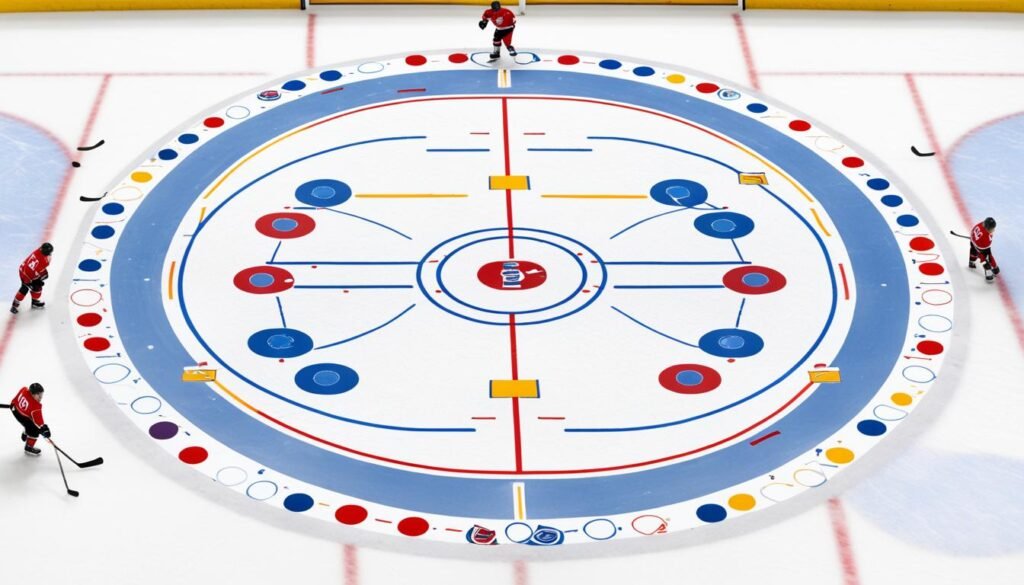In ice hockey, points have two meanings: as a personal statistic, points are awarded to players for goals scored and assists earned; as a team statistic, points are used to assess standings or rankings. In the NHL, the Art Ross Trophy is awarded to the player who leads the league in points at the end of the regular season.
How Do Points Work in Hockey
- Points in hockey have two meanings: personal statistics and team standings.
- Players earn points for goals scored and assists earned.
- The Art Ross Trophy is awarded to the player with the most points in the NHL.
- Points are used to assess team standings and rankings.
- The NHL uses a specific point system to determine standings and playoff qualification.
Personal Statistic: Goals and Assists
In ice hockey, players are awarded points for their individual achievements in the game. One of the main personal statistics in hockey is the combination of goals and assists. Let’s take a closer look at how these factors contribute to a player’s point total.
Goals
A goal is the ultimate achievement in hockey. When a player successfully puts the puck into the opposing team’s net, they are credited with a goal. Each goal a player scores is worth one point towards their total.
Assists
Assists are awarded to players who make a significant contribution to a goal-scoring play. An assist is credited to the player who made the last pass or played a key role in setting up the goal. Similar to goals, each assist earned by a player is also worth one point.
Total Points
The combination of goals and assists determines a player’s total points. For example, if a player has scored 20 goals and 30 assists in a season, their total point count would be 50.
It is worth mentioning that the player with the most points at the end of the regular season is awarded the prestigious Art Ross Trophy. This trophy recognizes the player who demonstrates exceptional offensive skills and consistently contributes to their team’s success.
Now that we understand how goals and assists contribute to a player’s point total, we can appreciate the importance of these statistics in evaluating their performance on the ice.
Team Statistic: Standings and Rankings
Points are an essential factor in assessing team standings and rankings in the NHL. Understanding the NHL points system is key to analyzing the success of teams throughout the season. Let’s take a closer look at how the NHL points system works and how it influences team rankings.
Historical Points System
In the past, NHL teams were awarded two points for a win, one point for a tie, and no points for a loss. This point system created a shared point between teams if the game resulted in a tie. However, this system was updated to better reflect the outcomes of games and encourage teams to play for a win.
Current NHL Points System
The current NHL point system awards two points for a win, one point for an overtime or shootout loss, and no points for a regulation loss. This system incentivizes teams to play for a regulation win while still rewarding them for pushing the game into overtime or a shootout. The revised system also eliminates ties, ensuring each game has a definitive outcome.
Teams are ranked based on their total points, wins, and goal differential. The points earned throughout the season determine a team’s position in the standings. The top-ranking teams in each conference qualify for the playoffs, with a total of 16 teams advancing to compete for the ultimate prize, the Stanley Cup.
NHL Points System
| Outcome | Points Awarded |
|---|---|
| Win (Regulation or Overtime) | 2 Points |
| Loss (Regulation) | 0 Points |
| Loss (Overtime or Shootout) | 1 Point |
The NHL points system ensures that teams are rewarded for their performance throughout the season. By earning points for wins and overtime/shootout losses, teams have the opportunity to climb the standings and secure their spot in the playoffs. Understanding the points system is crucial for fans and analysts to evaluate team success and make predictions about playoff qualification.
Points in Overtime and Shootouts
In the NHL, there are no longer ties. If a team loses in overtime or a shootout, they are awarded one point. This rule was implemented in the 1999-2000 NHL season. Supporters of the current point structure argue that the point for an overtime or shootout loss is not a point for losing, but rather a point earned for the initial draw, with teams winning in overtime or a shootout receiving an additional “bonus” point.
Understanding the NHL Points System
- The NHL points system underwent a major change in the 1999-2000 season to reduce the number of ties and create more exciting finishes.
- Prior to the change, teams would earn one point for a tie, regardless of the outcome of overtime or a shootout. This often led to games ending in ties, which some fans found unsatisfying.
- The new system awards two points for a win in regulation or overtime, one point for a loss in overtime or a shootout, and zero points for a regulation loss.
Implications of the Points System Change
The introduction of the point for an overtime or shootout loss added an extra incentive for teams to compete and play aggressively in overtime. It also increased the importance of shootouts in determining the outcome of games and playoff positioning.
Here is a breakdown of the possible points awarded in different game scenarios:
| Outcome | Points Awarded |
|---|---|
| Win in Regulation | 2 points |
| Win in Overtime or Shootout | 2 points |
| Loss in Overtime or Shootout | 1 point |
| Loss in Regulation | 0 points |
The updated points system has made games more exciting and increased the importance of each game. Teams now have an opportunity to earn points even in a loss, which can impact their standings and playoff qualification.
Understanding the NHL points system is crucial for both players and fans alike. It helps in evaluating team performance, tracking standings, and predicting playoff positioning. The points awarded in overtime and shootouts have significantly influenced the strategies and dynamics of the game, making every moment on the ice even more thrilling.
Points Systems in Other Leagues
While the NHL has its own unique point system, it’s important to note that many European leagues and tournaments, as well as the Professional Women’s Hockey League, follow different scoring rules. These alternate systems are designed to encourage teams to win in regulation time rather than relying on overtime or shootouts. Let’s take a look at one example:
Example Point System:
| Result | Points Awarded |
|---|---|
| Regulation Win | 3 |
| Overtime or Shootout Win | 2 |
| Overtime or Shootout Loss | 1 |
| Regulation Loss | 0 |
This system awards three points for a regulation win, two points for an overtime or shootout win, one point for an overtime or shootout loss, and no points for a regulation loss. The intention behind this point structure is to incentivize teams to play aggressively and secure wins within the standard allotted time.
It’s worth noting that this alternate scoring system bears some similarity to the point system used in soccer, where three points are awarded for a win, one point for a draw, and no points for a loss. By applying a similar approach, these leagues aim to prioritize the outcome of games played in regulation time.
By having an understanding of the different point systems used in various leagues, fans can appreciate the nuances of scoring and better comprehend the standings and rankings in different hockey competitions.

The Point Position in Hockey
In hockey, the point position refers to the area near the blue line and the boards in the offensive zone. This strategic position is crucial for both offense and defense, and it plays a significant role in power-play situations.
The term “the point” originated from the historical names of the defensive positions: point and cover point. These positions were traditionally responsible for guarding the area near the blue line and executing offensive plays.
When a team is on the power play, the defensemen usually take up positions at the point. They use their positioning and skills to control the puck, create scoring opportunities, and maintain offensive pressure. From the point, defensemen can unleash powerful shots on net, set up their teammates with accurate passes, or keep the puck in the offensive zone.
Here’s an example of how the point position can be utilized during a power play:
| Advantages of the Point Position in Power Play: | Disadvantages of the Point Position in Power Play: |
|---|---|
|
|
By understanding the significance of the point position, players and fans can gain insights into the tactical aspects of the game and appreciate the skill and strategy involved in power-play situations.
Understanding NHL Standings
The NHL standings serve as a crucial determining factor in which teams qualify for the highly anticipated Stanley Cup playoffs. The primary metric used to assess teams’ eligibility is the number of points they have earned throughout the regular season.
In each conference of the NHL, the top point-earning teams secure their place in the playoffs, totaling 16 teams in total (with 8 teams from each conference). This stringent qualification process ensures that only the best-performing teams have the opportunity to compete for the ultimate prize in hockey.
While points form the cornerstone of the standings, additional statistics are displayed to provide a comprehensive overview of a team’s performance. These include the number of wins, losses, and the all-important goal differential.
Let’s take a closer look at the standings and explore how teams’ point accumulation influences the playoff qualification process. Additionally, we’ll delve into the significance of wins, losses, and goal differential as key indicators of team success in the NHL.
Understanding the NHL Standings Table
When examining the NHL standings, it becomes evident that each team’s position is determined by various factors. The table below illustrates the typical layout of the standings:
| Rank | Team | Points | Wins | Losses | OT/SO Losses | Goal Differential |
|---|---|---|---|---|---|---|
| 1 | Colorado Avalanche | 104 | 48 | 20 | 5 | +60 |
| 2 | Carolina Hurricanes | 99 | 45 | 25 | 4 | +40 |
| 3 | Tampa Bay Lightning | 96 | 43 | 27 | 3 | +36 |

The standings table provides a comprehensive snapshot of the team standings, allowing fans to track their favorite teams’ progress throughout the season. It showcases essential information such as a team’s rank, total points earned, number of wins and losses, OT/SO (overtime/shootout) losses, and their goal differential.
By analyzing this data, fans can gauge a team’s overall performance, strengths, and weaknesses. The standings also offer valuable insight into the intense competition among NHL teams, highlighting the race for playoff qualification and the pursuit of the coveted Stanley Cup.
Conclusion
Understanding how points work in hockey is crucial for both players and fans. Points are awarded to players for goals scored and assists earned, showcasing individual performance on the ice. These personal statistics contribute to a player’s overall point total, which can have a significant impact on their standing within the league. Additionally, points are also used as a team statistic to assess standings and rankings, determining which teams qualify for the playoffs.
The National Hockey League (NHL) employs a specific point system where teams earn two points for a win, one point for an overtime or shootout loss, and no points for a regulation loss. This point system allows fans to closely follow the standings and identify the top-performing teams in each conference. It’s through understanding the point system that fans can gauge which teams are in contention for playoff spots and anticipate the excitement of postseason play.
However, it’s important to note that not all leagues and tournaments adhere to the same point system as the NHL. Variations exist, such as the three-point system used in many European leagues, where teams can earn three points for a regulation win. These variations add a unique element to the game and contribute to the diverse nature of hockey around the world.
Comprehending the intricacies of the hockey points system and scoring rules is essential for players and fans alike. By understanding how points are allocated and how they impact team standings, fans can fully immerse themselves in the excitement of the game and appreciate the skill and strategy required to earn those valuable points.







